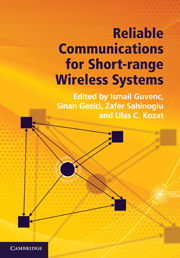Book contents
- Frontmatter
- Contents
- List of contributors
- 1 Short-range wireless communications and reliability
- Part I High-rate systems
- Part II Low-rate systems
- 6 ZigBee networks and low-rate UWB communications
- 7 Impact of channel estimation on reliability
- 8 Interference mitigation and awareness for improved reliability
- 9 Characterization of Wi-Fi interference for dynamic channel allocation in WPANs
- 10 Energy saving in low-rate systems
- Part II Selected topics for improved reliability
- Index
9 - Characterization of Wi-Fi interference for dynamic channel allocation in WPANs
from Part II - Low-rate systems
Published online by Cambridge University Press: 01 June 2011
- Frontmatter
- Contents
- List of contributors
- 1 Short-range wireless communications and reliability
- Part I High-rate systems
- Part II Low-rate systems
- 6 ZigBee networks and low-rate UWB communications
- 7 Impact of channel estimation on reliability
- 8 Interference mitigation and awareness for improved reliability
- 9 Characterization of Wi-Fi interference for dynamic channel allocation in WPANs
- 10 Energy saving in low-rate systems
- Part II Selected topics for improved reliability
- Index
Summary
Towards adaptive wireless personal area networks (WPANs)
Introduction and motivation
Recent years have witnessed a growing demand on wireless technologies, thanks to their convenience and the variety of services offered. This success is leading to an increasing adoption of wireless systems, especially the ones operating in the unlicensed 2.4 GHz industrial, scientific, and medical (ISM) frequency band. As a result, the spectrum is overcrowded and shared by a variety of standards, causing serious coexistence problems due to their cross-interference: this may lead to performance degradation or even network malfunctioning.
To overcome the problem of spectrum scarcity, and allow the network to maintain its level of performance and reliability, a cognitive radio (CR) approach can be applied. As will be discussed here, this emerging wireless communication paradigm aims at providing a more effective and flexible spectrum usage by observing the radio environment and adapting transmission parameters consequently. According to the CR approach, instead of a fixed frequency assignment, smart nodes are envisioned to constantly perform “spectrum sensing” and dynamically allocate themselves to the best available channel, thus achieving reliable and spectrally efficient communication. The first step towards the implementation of a CR system is the characterization of interference between coexisting systems. This chapter in particular focuses on wireless personal area networks (WPANs), based on the IEEE 802.15.4 standard, operating in the presence of IEEE 802.11b Wi-Fi traffic. As is evident in Figure 9.1, there is an almost complete overlap between the channels allocated for these two systems [1, 2].
- Type
- Chapter
- Information
- Reliable Communications for Short-Range Wireless Systems , pp. 234 - 269Publisher: Cambridge University PressPrint publication year: 2011
- 2
- Cited by



